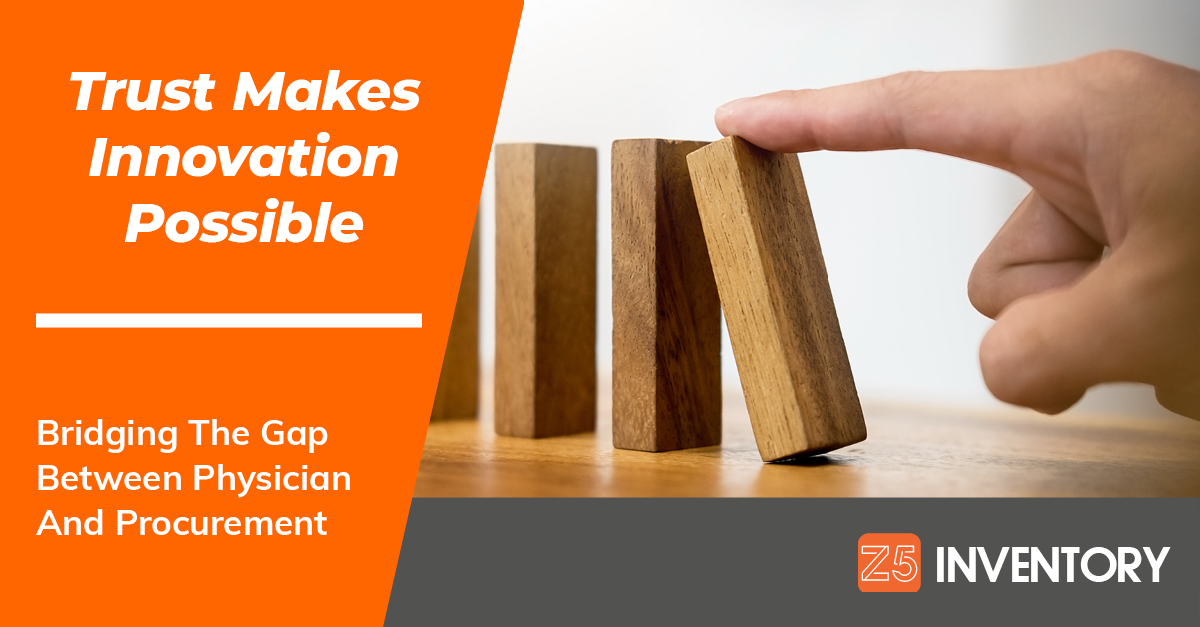Gaining Trust To Make Innovation Possible

We’ve all had to adapt to a new normal during COVID-19, and those of us in the healthcare supply chain have had to adapt more than most. But the real question we have to answer now is: how can we take what we’ve learned and apply it to inventory management overall?
That was the subject of our recent episodes of Take 5: An Inventory Series where we talked to Michael Prokopis, SVP of Supply Chain at Steward Health Care. We got his take on how they’re innovating not only during the coronavirus crisis, but because of it. And we asked him what’s coming next.
(Yes, we know, we’re not out of the COVID-19 woods, but if you never start preparing for the next emergency, you’ll always be putting out fires, and that’s no way to live.)
Earn Trust
This year has been make-or-break for clinician-materials management relations. Each side has judged the other on how responsive, flexible, and reliable they’ve been.
The most obvious example of this is in product availability. The physicians who had to make their own sterile gowns out of trash bags are going to be more skeptical when it comes to their procurement professionals than those who – like Steward healthcare workers – never ran out of PPE. Most will fall somewhere in the middle. Which is actually okay.
Negotiating has been a key skill that those dealing with outside agencies – vendors, solution providers, and the like – have brought into their facilities. Finding compromises on physician preference has been pretty easy when the options are A) having all the supplies but some of them are not the favorite brand or product line, and B) having shortages. Keeping some product in stock, even if it’s not everyone’s favorite, is a crucial step in solidifying the relationship between these different hospital departments.
And, with a few good relationships throughout the system, you can foster communication and innovation for the next stage of implementing innovation…
Test New Ideas
Supply chain probably has a few new policies and initiatives that they’d like to try out, and more than a few must’ve come from this year’s struggles. And the clinical side is no different. Knowing who the champions and innovators are at each facility is a great first step to finding out what to try next.
Solicit ideas from the people who are pulling the product off the shelves every day, whether that be department-level medical or materials staff. See what new ideas they’re coming up with or find out where they’re struggling, because they have the greatest insight into how product is actually being used.
Then start investigating the solution. Maybe you want to put a pilot program into place and evaluate how much more efficient your process gets. Maybe you want to run an analysis before you order anything to evaluate how cost-effective standardizing your products will be. Maybe you need specific outside or inside experts to do the evaluation for you.
But that one constant through the process – evaluation – must remain constant throughout your innovation process. Otherwise, you’re not innovating. You’re trying new things, but you’re not necessarily improving. If you are, purely by accident, you don’t have the data to help you succeed next time. You’ll have to rely on another happy accident.
And part of that evaluation process might be finding out that you already have something that meets your needs but isn’t implemented everywhere. Or you might find that a slight improvement on a process that’s currently in place in one facility that could benefit everyone.
All of this evaluation will help you in the final stage…
Decide What’s Next
The process of evaluating current and potential product and procedures should help you determine not only what your next initiative will be but where you should prioritize it on the schedule.
Ideally your innovations should meet the following criteria: 1) it should lower the cost or complication of delivering healthcare to your patients, and 2) the burden it places on staff to implement and execute should not exceed the burden placed on them by current practices.
Take the AI camera example that Michael Prokopis presented in our podcast episode. If a camera monitoring inventory levels saves supply chain and clinical staff time, it’s probably worth the investment. But if supply chain and clinical staff are constantly having to check and correct the results of the AI camera’s analysis, it’s a waste. You ought to be freeing up resources with each new project and product.
What’s coming up that fulfills those requirements? Centralized procurement that breaks up bulk orders and distributes quantities according to need. The remote inventory level monitoring that Mr. Prokopis mentioned. And more remote work, period, as we talked about with Hays Waldrop.
All of which will require extensive experimentation and evaluation. Case studies of past successes get you part of the way there. But ultimately you’ll need to give it a try yourself. You have to know what works before you put it to work.


